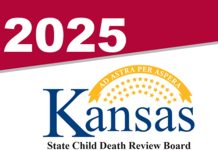The percentage of Kansas children without health insurance climbed to its highest level in a little more than a decade, reflecting a national trend as states unwound from a federal law that kept beneficiaries on the Medicaid rolls during the pandemic.
New census data shows that 7% of Kansas children under 19 – or about 51,300 kids – didn’t have health insurance in 2024, the highest percentage since it was 7.1% in 2012, according to census data compiled by the Kansas Health Institute.
The national average for uninsured children is 6%, according to the Census Bureau.
The percentage of Kansas children without health insurance climbed 1.4 percentage points from 2023, the third biggest increase among Midwestern states, the data show.
The only Midwest states with bigger percentage increases were North Dakota with a 3.1 percentage point increase to 6.7% and Nebraska with a 1.6 percentage point increase to 5.3%.
Overall, the uninsurance rate in Kansas for 2024 was 8.5%, a slight increase from 8.4% the year before but not considered statistically significant.
The national average for the uninsurance rate is 8.2%. Kansas has exceeded the overall national uninsured rate four years in a row.
“We’re starting to see the effects of the unwinding process,” said Sheena Schmidt, senior analyst and strategy team leader for the Kansas Health Institute.
Starting in April 2023, states across the country unwound from a continuous enrollment provision in federal law that blocked beneficiaries from being removed from the Medicaid rolls during the pandemic.
The federal government suspended yearly Medicaid eligibility reviews during the COVID-19 pandemic emergency, but they started up again under legislation passed by Congress.
“As people were required to redetermine their eligibility for Medicaid, children and adults lost coverage,” Schmidt said in an interview.
“It’s looking like that policy change definitely impacted the uninsured rate for children in Kansas,” she said.
During 2024, uninsured rates among children ranged nationally from a low of 2.1% in Massachusetts to a high of 13.6% in Texas, according to a Census Bureau report.
The uninsured rate for children was higher than the national average in 13 states, according to the Census Bureau.
“Most of these states were in the Southern and Western regions, with Texas having the highest uninsured rate,” the Census Bureau reported.
“There could be several contributing factors, but without a doubt, the Medicaid unwinding that finished up in the spring of 2024 is a primary cause of the uninsured rate among children increasing,” said Heather Braum, senior policy adviser for Kansas Action for Children.
“We know many kids likely remained eligible, but lost their coverage due to a number of factors, like their parents’ understanding of eligibility or the complicated process to apply,” Braum said in a statement.
“Kansas can do much more to make it easier for families to access and afford health coverage by eliminating hoops they have to jump through.”
The Georgetown University McCourt School of Public Policy reported that net enrollment for children in Medicaid nationally fell about 5.5 million during unwinding including about 53,000 in Kansas.
KHI officials caution that the issue could worsen over time with more changes in Medicaid policy that will take effect in the coming years.
Most notably, the enhanced premium tax credit that covers the cost of premiums on the Affordable Care Act exchange is set to expire by the end of the year, potentially causing millions to fall off the insurance rolls in 2026.
The Centers for Medicare & Medicaid Services reported that 200,046 Kansans signed up for a health insurance plan offered by the ACA for 2025.
It’s a 16.7% increase from the 171,376 who enrolled in the ACA last year and almost 3 1/2 times more than the 57,013 who enrolled the first year the benefit was available, in 2014.
Five insurers – Blue Cross and Blue Shield of Kansas, UnitedHealthcare, Celtic Insurance, Medica Insurance and Oscar Insurance – have filed requests for average rate increases ranging from 10.1% to 39.9%.
If the enhanced subsidies are not renewed, the premiums for people enrolled in an ACA plan would increase by more than 75% nationally on average, with people in some states seeing their payments more than double, health care think tank KFF reported.
“The expectation is that it is going to make a significant impact on the number of people who have coverage,” said Linda Sheppard, senior analyst and strategy team leader who works on state and federal health policy issues for KHI.
“That is going to effect the children because if Mom or Dad lose coverage, then the kids are going to be without as well,” Sheppard said.
KHI also came to other conclusions after reviewing the new census data. They found:
Low-income Kansans: Kansans living below 138% of the federal poverty level – the threshold to qualify for Medicaid eligibility in expansion states – were more likely to be uninsured than those in similar circumstances in the U.S. The uninsured rate for this group of Kansans rose to 18.4% last year from 16.1% in 2023.
Racial and ethnicity disparities: Among Hispanic Kansans of any race, the uninsured rate of 22% was nearly four times higher than the rate for non-Hispanic white Kansans with a rate of 5.8%. Among African American Kansans, the uninsured rate of 11.4% was nearly two times higher than non-Hispanic white Kansans, and higher than the national rate of 8.9% for the African American population.
Young adults: The uninsured rate among Kansans 19 to 25 remained similar to the U.S. rate, 14.2% to 14%. The rate among this group rose to 14.2% last year from 14% in 2023, according to the data compiled by KHI.
Working-age adults: The uninsured rate for adults ages 19-64 in Kansas was 11.7%, similar to the U.S. rate of 11.3%. This group saw a statistically significant increase in the U.S., rising to 11.3% in 2024 from 11% the year before. The percent of the same group in Kansas fell to 11.7% in 2024 from 11.9% in 2023. In 2024, the uninsured rate among working-age adults ranged from a low of 3.7% in Massachusetts to a high of 21.6% in Texas, the Census Bureau reported.















